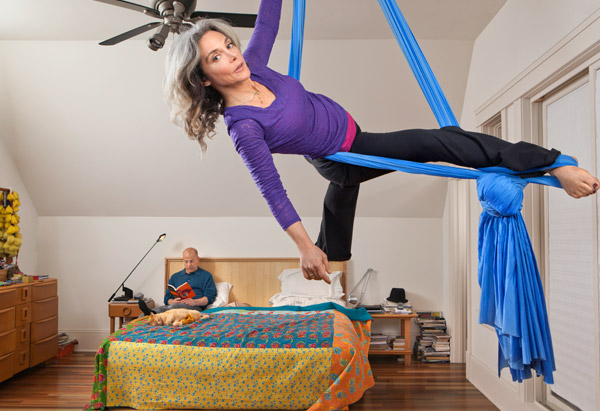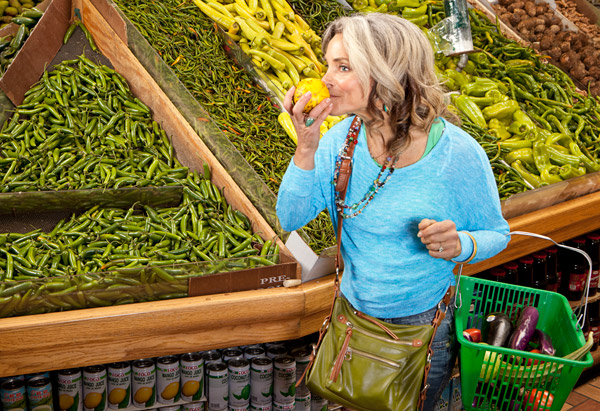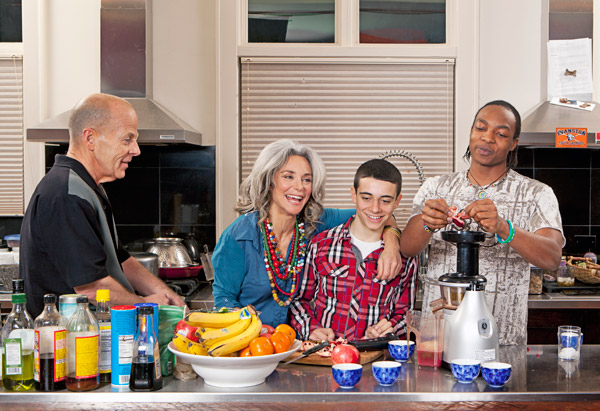Do you approach aging with resignation—maybe even a little bit of dread? If so, consider the example of Toni Bark, MD, the force of nature for whom 52 feels a lot like 25 and every day is a zesty, nut-buttery banquet.

Photo: Gregg Segal
Toni Bark is hanging upside down by a length of fabric suspended from the ceiling. Her silver hair almost touches the floor while her magenta toenails point north. Then she performs a set of midair sit-ups.
"This is all about your hips! No arms, Toni!" shouts the instructor, Sylvia Hernandez-DiStasi, a former acrobat for Ringling Bros. "You just want a lift and a real tight crunch. When you're tired, you can stop. No, actually, when you're tired you can do three more." If Bark is struggling, she doesn't show it. At the end of the brutal set, she twists out of the fabric, flipping onto the padded floor, graceful as a cat. A few days later she'll spend an hour on a trapeze and in a circular metal lyra, floating across the gymnasium. A one-time paraglider, Bark loves the sensation of weightlessness so much, she installed a trampoline in her backyard and both an aerial silk and a trapeze in the bedroom.
After class we walk out of the gym into the bright January sunlight of Evanston, a suburb of Chicago, where Bark lives.
"Come to Monday night class!" she says, bouncing along in her green tennies. "That's when I feel like I'm really flying."
If, for most people, middle age is the plodding business of accepting what we haven't done, can't do, and never will—of indulging a litany of aches and pains and facing our mortality—for Toni Bark, it's the time of her life. With the lusty vigor of an undergrad, Bark, at 52, approaches these years as something thrilling and immeasurably precious.
Of course, she has been this way at every age, which accounts for her frenetically impressive résumé: ER doctor. Homeopath. Environmental designer. Belly dancer.
"My parents told me I'm the only person they know who went to med school as a hobby," Bark says later as we walk her Chihuahua, Neisha, on the beach, not far from her home. It's a 4,700-square-foot geothermal affair designed by Bark and her husband, David Dwyer, that draws and stores a huge amount of heat and light from the house's 50 windows. The space—decorated with eclectic mementos and a mini-forest of potted bamboo—is generally filled with a revolving cast of man-boys: neighborhood friends of her son, Ayal, 15; her stepson, Joey, 19; and Trinidad Twagirumukiza, a 22-year-old Rwandan Tutsi refugee she and Dwyer support.
With deep blue eyes that offset her wild silver mane, a sapphire stud in her left nostril, and a penchant for musky scents like Fir-ever Young, she looks more performance artist than medical dynamo—one who researches and lectures on vaccine safety, races off to disaster sites like Haiti after the earthquake to help out, and spreads the gospel of wellness in her homeopathy practice, the Center for Disease Prevention and Reversal. In homeopathy the big idea is to restore the body's natural balance by working with its own defenses, taking into account the entire patient by making connections between emotions and afflictions. As Bark says, "I look at the whole picture. I've never seen a body walk in without its head."
That passion for her work, the energy, the joy...I have to ask—what drives her?
"I don't know," she says, genuinely puzzled, digging her toes in the sand after a few triangle stretches. "What's the alternative—sitting around and watching TV? I don't know any other way."
Next: The secret to her energy
"This is all about your hips! No arms, Toni!" shouts the instructor, Sylvia Hernandez-DiStasi, a former acrobat for Ringling Bros. "You just want a lift and a real tight crunch. When you're tired, you can stop. No, actually, when you're tired you can do three more." If Bark is struggling, she doesn't show it. At the end of the brutal set, she twists out of the fabric, flipping onto the padded floor, graceful as a cat. A few days later she'll spend an hour on a trapeze and in a circular metal lyra, floating across the gymnasium. A one-time paraglider, Bark loves the sensation of weightlessness so much, she installed a trampoline in her backyard and both an aerial silk and a trapeze in the bedroom.
After class we walk out of the gym into the bright January sunlight of Evanston, a suburb of Chicago, where Bark lives.
"Come to Monday night class!" she says, bouncing along in her green tennies. "That's when I feel like I'm really flying."
If, for most people, middle age is the plodding business of accepting what we haven't done, can't do, and never will—of indulging a litany of aches and pains and facing our mortality—for Toni Bark, it's the time of her life. With the lusty vigor of an undergrad, Bark, at 52, approaches these years as something thrilling and immeasurably precious.
Of course, she has been this way at every age, which accounts for her frenetically impressive résumé: ER doctor. Homeopath. Environmental designer. Belly dancer.
"My parents told me I'm the only person they know who went to med school as a hobby," Bark says later as we walk her Chihuahua, Neisha, on the beach, not far from her home. It's a 4,700-square-foot geothermal affair designed by Bark and her husband, David Dwyer, that draws and stores a huge amount of heat and light from the house's 50 windows. The space—decorated with eclectic mementos and a mini-forest of potted bamboo—is generally filled with a revolving cast of man-boys: neighborhood friends of her son, Ayal, 15; her stepson, Joey, 19; and Trinidad Twagirumukiza, a 22-year-old Rwandan Tutsi refugee she and Dwyer support.
With deep blue eyes that offset her wild silver mane, a sapphire stud in her left nostril, and a penchant for musky scents like Fir-ever Young, she looks more performance artist than medical dynamo—one who researches and lectures on vaccine safety, races off to disaster sites like Haiti after the earthquake to help out, and spreads the gospel of wellness in her homeopathy practice, the Center for Disease Prevention and Reversal. In homeopathy the big idea is to restore the body's natural balance by working with its own defenses, taking into account the entire patient by making connections between emotions and afflictions. As Bark says, "I look at the whole picture. I've never seen a body walk in without its head."
That passion for her work, the energy, the joy...I have to ask—what drives her?
"I don't know," she says, genuinely puzzled, digging her toes in the sand after a few triangle stretches. "What's the alternative—sitting around and watching TV? I don't know any other way."
Next: The secret to her energy

Photo: Gregg Segal
So how do the rest of us get some of what Bark's got? The good news is, you don't have to be born with it—even if Bark was. Her father worked as a trader in Chicago and flew planes in his spare time, introducing Bark to downhill skiing when she was 5. Her mother was a real estate agent and an excellent cook. Both parents had an affinity for staying active and eating healthy—one of Bark's earliest memories is of her father's giant bowl of vitamins in the kitchen.
They also encouraged their daughter to be an independent thinker, which accounts for her refreshing take on what it means to be (and eat) healthy. Caffeine is okay, and so is alcohol, in moderation; Bark calls any good red wine—say, Spanish Garnacha-Tempranillo—"nectar of the gods." Confronted with a high-grade tequila, she might even do a shot. She's also a big fan of fats—the "good" kind you find in nut butters and avocados. As for counting calories, "it's a huge mistake," Bark says. "It creates such an obsessive pattern. If you want to do something like look at calories, look at how many carbs you're eating. If you have a sedentary job, you need to reduce the carbs. Don't stuff your face because you don't like your boss; don't reward yourself with crappy food. The goal is to enjoy your food and have a really good relationship with it. A good relationship with your food should be nonnegotiable."
After the circus fitness class, we head to Fresh Farms International Market, where I receive my first lesson in the little-known pleasures of grocery shopping.
"Lita squash!" she says. "This is so much better than a regular zucchini!"
Almost everything Bark eats is low on the glycemic index and mostly vegan, with the exception of fish once a week. She also practically mainlines nuts and seeds of all kinds. "Low-glycemic foods help keep your blood sugar levels stable and your insulin levels low, so you can think more clearly and have more energy," she says.
Next in the basket go pomegranate seeds, curry leaves, ginger, avocados, raspberries, and teff, a grain she uses for baking. In the frozen food aisle, Bark puts her head down and studies some nutrition labels—"I look for ingredients that existed 100 years ago, so I know they're clean," she says. "I would never eat anything with hydrogenated fats or cottonseed oil, which is used in all kinds of cheap snacks." By the time we're at the checkout counter, the basket is packed with unprocessed goodness—ingredients for more meals like the incredible one we had last night: curried split pea soup, sweet potatoes, pasta made from raw kelp noodles with carrots, broccoli, and cauliflower in creamy cashew coconut curry sauce, dehydrated pesto crackers, and, for dessert, poached pears with sake and cinnamon.
Bark usually cooks on an induction range and has a dehydrator in the corner that she uses to make crackers as well as the "pancakes" she eats every morning: hockey pucks made of maca root, mesquite, chia seeds, macadamia nuts, dried mulberries, and cinnamon that she tops with coconut butter, fresh fruit, and pure maple syrup. The recycled stainless steel countertops are covered with jars, boxes, and BPA-free plastic containers full of organic herbs, spices, and oils. Hanging over the kitchen island, as if to bless this sacred eating space, are bright, sequined Haitian voodoo flags.
By way of relaxing, Bark whips up a batch of "brownies" from raw cocoa and what look like salad fixings (dates, avocados, and basil) while contemplating the thorny business of aging.
Next: Bark's beauty regimen
They also encouraged their daughter to be an independent thinker, which accounts for her refreshing take on what it means to be (and eat) healthy. Caffeine is okay, and so is alcohol, in moderation; Bark calls any good red wine—say, Spanish Garnacha-Tempranillo—"nectar of the gods." Confronted with a high-grade tequila, she might even do a shot. She's also a big fan of fats—the "good" kind you find in nut butters and avocados. As for counting calories, "it's a huge mistake," Bark says. "It creates such an obsessive pattern. If you want to do something like look at calories, look at how many carbs you're eating. If you have a sedentary job, you need to reduce the carbs. Don't stuff your face because you don't like your boss; don't reward yourself with crappy food. The goal is to enjoy your food and have a really good relationship with it. A good relationship with your food should be nonnegotiable."
After the circus fitness class, we head to Fresh Farms International Market, where I receive my first lesson in the little-known pleasures of grocery shopping.
"Lita squash!" she says. "This is so much better than a regular zucchini!"
Almost everything Bark eats is low on the glycemic index and mostly vegan, with the exception of fish once a week. She also practically mainlines nuts and seeds of all kinds. "Low-glycemic foods help keep your blood sugar levels stable and your insulin levels low, so you can think more clearly and have more energy," she says.
Next in the basket go pomegranate seeds, curry leaves, ginger, avocados, raspberries, and teff, a grain she uses for baking. In the frozen food aisle, Bark puts her head down and studies some nutrition labels—"I look for ingredients that existed 100 years ago, so I know they're clean," she says. "I would never eat anything with hydrogenated fats or cottonseed oil, which is used in all kinds of cheap snacks." By the time we're at the checkout counter, the basket is packed with unprocessed goodness—ingredients for more meals like the incredible one we had last night: curried split pea soup, sweet potatoes, pasta made from raw kelp noodles with carrots, broccoli, and cauliflower in creamy cashew coconut curry sauce, dehydrated pesto crackers, and, for dessert, poached pears with sake and cinnamon.
Bark usually cooks on an induction range and has a dehydrator in the corner that she uses to make crackers as well as the "pancakes" she eats every morning: hockey pucks made of maca root, mesquite, chia seeds, macadamia nuts, dried mulberries, and cinnamon that she tops with coconut butter, fresh fruit, and pure maple syrup. The recycled stainless steel countertops are covered with jars, boxes, and BPA-free plastic containers full of organic herbs, spices, and oils. Hanging over the kitchen island, as if to bless this sacred eating space, are bright, sequined Haitian voodoo flags.
By way of relaxing, Bark whips up a batch of "brownies" from raw cocoa and what look like salad fixings (dates, avocados, and basil) while contemplating the thorny business of aging.
Next: Bark's beauty regimen

Photo: Gregg Segal
"If I were the American standard of beauty, I'd have colored, blow-dried hair," she tells me, licking chocolate from a mixing bowl. "It's not that I'm against it; I'm trained in Botox"—as well as an injection therapy that claims to dissolve fat. "But less is more. It should be subtle, like you look rested. I try to get eight to ten hours of sleep per night. The mistake is that people focus on the external stuff. I'm not antiaging; I'm more about longevity, health, and keeping your mojo."
"Would I rather look like I did ten years ago? Yes. But I don't. So what am I going to do about it? It's not going to stop me."
To keep her skin looking luminescent, Bark uses a "dermal needle roller," a handheld device studded with dozens of tiny needles. The roller causes controlled injury, which she says stimulates collagen production and blood flow. Every few days, she exfoliates and cleanses using a floss silk mitt and papaya seeds, honey, and apple cider vinegar, then slathers oils, from broccoli seed to cranberry seed to sea buckthorn, on her face and neck. The system seems to be working beautifully.
I ask Bark what's on the schedule for tomorrow.
"I might drag your sorry ass to hip-hop," she says.
The mere thought of following Bark's example is exhausting. I'm ten years younger than she is, and all I want to do tomorrow is curl up and chat. But Bark's message gets under your skin. For instance, I see now that living full-tilt is an active choice. "Things don't just come your way and happen; you make them happen," she says. "Go out and seek adventure, knowledge, wisdom, fun."
At hip-hop class, Bark, wearing her trademark green tennies, is front and center—never mind that she's the oldest student in the coed, ten-person mix. She breezes through the complicated routine, adding her own gyrations and hair flips, looking like she could back up Beyoncé. More to the point, though, she just looks happy. Present, and fully engaged.
"You get what you give," she tells me later. "I give to a lot of people—my patients, my family, my community—and I get it back many times over."
Or as Bark's hip-hop instructor puts it, "Toni is like Wonder Woman. All she needs is the costume."
Stephanie Pearson is a contributing editor at Outside Magazine.
More Fresh Ideas for Staying Healthy
"Would I rather look like I did ten years ago? Yes. But I don't. So what am I going to do about it? It's not going to stop me."
To keep her skin looking luminescent, Bark uses a "dermal needle roller," a handheld device studded with dozens of tiny needles. The roller causes controlled injury, which she says stimulates collagen production and blood flow. Every few days, she exfoliates and cleanses using a floss silk mitt and papaya seeds, honey, and apple cider vinegar, then slathers oils, from broccoli seed to cranberry seed to sea buckthorn, on her face and neck. The system seems to be working beautifully.
I ask Bark what's on the schedule for tomorrow.
"I might drag your sorry ass to hip-hop," she says.
The mere thought of following Bark's example is exhausting. I'm ten years younger than she is, and all I want to do tomorrow is curl up and chat. But Bark's message gets under your skin. For instance, I see now that living full-tilt is an active choice. "Things don't just come your way and happen; you make them happen," she says. "Go out and seek adventure, knowledge, wisdom, fun."
At hip-hop class, Bark, wearing her trademark green tennies, is front and center—never mind that she's the oldest student in the coed, ten-person mix. She breezes through the complicated routine, adding her own gyrations and hair flips, looking like she could back up Beyoncé. More to the point, though, she just looks happy. Present, and fully engaged.
"You get what you give," she tells me later. "I give to a lot of people—my patients, my family, my community—and I get it back many times over."
Or as Bark's hip-hop instructor puts it, "Toni is like Wonder Woman. All she needs is the costume."
Stephanie Pearson is a contributing editor at Outside Magazine.
More Fresh Ideas for Staying Healthy




